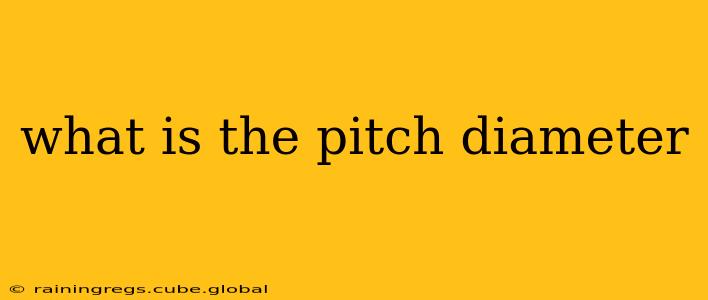The pitch diameter is a crucial measurement in mechanical engineering, specifically when dealing with threaded fasteners like screws, bolts, and nuts. It represents the diameter of an imaginary cylinder that would pass through the points where the thread flanks intersect. Understanding the pitch diameter is vital for accurate calculations involving the strength, fit, and function of threaded components. It's not a directly measurable dimension, unlike the major or minor diameter, but rather a calculated value based on other measurable parameters.
What is the difference between pitch diameter, major diameter, and minor diameter?
These three diameters—pitch, major, and minor—are all related to the thread profile but represent different aspects:
-
Major Diameter: This is the largest diameter of the thread, measured across the crests (top points) of the threads. It's the easiest diameter to measure directly with tools like calipers.
-
Minor Diameter: This is the smallest diameter of the thread, measured across the roots (bottom points) of the threads. This is also relatively straightforward to measure directly.
-
Pitch Diameter: This is the theoretical diameter that represents the average of the major and minor diameters. It's not a dimension you can measure directly with a simple caliper; instead, it's calculated using the major diameter, minor diameter, and the thread's lead angle (the angle of the helix formed by the thread). It’s crucial because it defines the effective working diameter of the threaded fastener.
How is the pitch diameter calculated?
The exact formula for calculating pitch diameter varies slightly depending on the thread profile (e.g., metric, Unified National Coarse [UNC], Unified National Fine [UNF]). However, a common approach involves using the major diameter (D), minor diameter (d), and the pitch (p):
-
Simplified Approximation: A rough estimate can be obtained by averaging the major and minor diameters: Pitch Diameter ≈ (D + d) / 2. This is useful for quick estimations, but it is not precise.
-
Precise Calculations: For precise calculations, you need to consult standards specific to the thread form (e.g., ISO standards for metric threads, ANSI standards for UNC/UNF threads). These standards provide formulas that incorporate factors accounting for the thread's geometry, including the thread angle. These formulas are usually more complex and involve trigonometric functions.
What is the significance of pitch diameter in engineering?
The pitch diameter plays a vital role in many engineering calculations:
-
Thread Engagement: It defines the effective amount of contact between mating threads, impacting the clamping force and strength of the connection.
-
Stress Calculations: The pitch diameter is used to calculate stresses within the threaded component under load.
-
Torque Calculations: It’s essential for determining the torque needed to achieve a specific clamping force or for predicting the torque a threaded joint can withstand.
-
Gage Design: Accurate pitch diameter is crucial for the design and manufacturing of thread gauges used to check thread accuracy.
-
Interchangeability: It ensures the proper fit and interchangeability between threaded components from different manufacturers.
Why is it important to know the pitch diameter?
Precise knowledge of the pitch diameter is critical for ensuring the reliable performance and safety of any threaded connection. An inaccurate pitch diameter could lead to inadequate clamping force, premature thread failure, or even catastrophic component failure.
How do I find the pitch diameter of a specific bolt?
Determining the pitch diameter of a specific bolt often requires referring to engineering drawings, specifications, or using specialized measuring instruments. The manufacturer's documentation will typically provide the necessary dimensions.
This detailed explanation hopefully clarifies the concept and significance of pitch diameter in mechanical engineering. Remember to always consult relevant standards and specifications for accurate calculations and reliable design practices.
